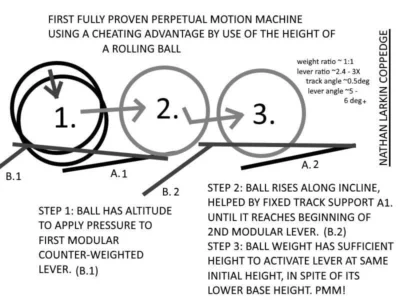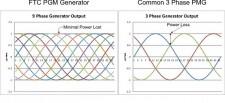
Press Release (ePRNews.com) - NEW HAVEN, Conn. - Apr 10, 2017 (UTC) - https://www.youtube.com/watch?v=l-js6SrgT5I
On Nov. 9 – 10, 2013 a not-much-known hobby inventor named Nathan Coppedge engaged in a deceptively simple experiment involving a marble, a very narrow lever weighted on its short end, and a double-sided makeshift track constructed of cardboard.
The experiment was an attempt to prove the long-sought foundation for perpetual motion.
Coppedge recalls that on that day, in the very early morning, two or three of his cieling lights coincidentally burnt out simultaneously. Nonetheless, he felt prepared to celebrate, because he had just proved, was perhaps the first in history to prove, that an object could lift the same object that lifted it, with no additional forces involved.
That the lights burnt out was very strange, because Coppedge’s experiment did not even involve electricity.
It was not until two-and-a-half years later on July 12th 2016, at 6pm that Coppedge says he may have overcome the last difficulty remaining in the way of a completely successful design.
True, Coppedge has faced considerable criticism, which I will mention later. The scientific establishment is not the least bit excited.
Coppedge describes a design (reproduced in the diagram) in which a similarly proven principle would no longer be restricted by what he calls conventional physics.
The key to doing this, he says, is very simple. Simpler than anyone could have imagined. Although the partial experiment itself is proven to work, it is not until the arrangement is repeated in a horizontal loop, and the size of the marble is significantly increased that the possible advantages of the design are discovered.
He says this design may “overcome the last barrier to perpetual motion” because the design produces three advantages (momentum, leverage, and room) at the end of each unit.
However, Coppedge has been slow to build a complete model. He says the materials are too expensive, and he would rather wait for mathematicians, engineers, and physicists to model his design on a computer. He thinks it would be too dangerous for “the builder and the designer to be one.”
He also cites difficulties with construction. He has tried building experiments with foamboard and masonite, but ultimately decided to work with plastic constructor toys, duct tape, and a specific type of cardboard he can only find from books he buys online.
The opposition to his designs has been fierce, not to mention generalized.
At a website called Revolution-Green dealing with energy news, members decried his “very poor video quality” and together agreed that he didn’t have the correct type of level to make accurate measurements. One member said that the experiment “could not be doing what [he]… [said] it is doing”.
Months later, at the Quora social media site results were not more positive.
Joe Rovito repeated the usual mantra: “Conservation of energy… Energy can neither be created nor destroyed.” Blumenkranz, who says he was a student at Stanford, said the device had a “failure to recognize its own energy loss mechanisms.” Eric Jones, who says he has a degree in science, went further, and called it “Ridiculous!” but suspected a hidden motor.
Will Coppedge’s experiments always be faced by such forthright denials, or will science someday accept that he was to an extent an unrecognized genius? Only time will tell.
https://www.quora.com/profile/Nathan-Coppedge
Source : Nathan CoppedgeNathan Coppedge
New Haven, Connecticut - 06510 United States
Website: http://www.quora.com/profile/Nathan-Coppedge





